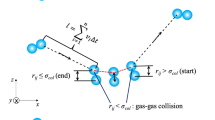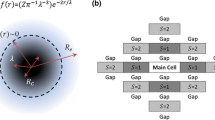Abstract
A hybrid atomistic-continuum method devoted to the study of multi-scale problems is presented. The simulation domain is decomposed into three regions: the bulk where the continuous Navier–Stokes and energy equations are solved, the neighbourhood of the wall simulated by the molecular dynamics and the overlap region which connects the macroscopic variables (velocity and temperature) between the former two regions. For the simulation of long micro/nanochannels, we adopt multiple molecular blocks along the flow direction, what enables the accurate capture of the velocity and temperature variations from the inlet to the outlet. The validity of the hybrid method is shown by comparisons with both analytical solutions and finite-volume simulations. This method is then applied successfully to the study the hydrodynamic and thermal development of a liquid flow in a long micro/nanochannel.












Similar content being viewed by others
References
Allen M, Tildesley D (1989) Computer simulation of liquids. Oxford University Press, New York
Berendsen HJC, Postma JPM, van Gunsteren WF, DiNola A, Haak JR (1984) Molecular dynamics with coupling to an external bath. J Chem Phys 81(8):3684–3690
Borg MK, Lockerby DA, Reese JM (2015) A hybrid molecular–continuum method for unsteady compressible multiscale flows. J Fluid Mech 768:388–414
Bugel M (2009) Couplage entre la Dynamique Moléculaire et la Mécanique des Milieux Continus, PhD thesis, Université de Bordeaux I
Bugel M, Galliéro G (2008) Thermal conductivity of the Lennard-Jones fluid: an empirical correlation. Chem Phys 352:249–257
Bugel M, Galliéro G, Caltagirone J-P (2011) Hybrid atomistics-continuum simulations of fluid flows involving interfaces. Microfluid Nanofluid 10(3):637–647
Chénier E, Eymard R, Touazi O (2006) Numerical results using a colocated finite-volume scheme on unstructured grids for incompressible fluid flows. Numer Heat Transf B-Fund 49(3):259–276
Chénier E, Eymard R, Herbin R, Touazi O (2008) Collocated finite volume schemes for the simulation of natural convective flows on unstructured meshes. Int J Numer Methods Fluids 56(11):2045–2068
Delgado-Buscalioni R, Coveney PV (2003) Continuum-particle hybrid coupling for mass, momentum, and energy transfers in unsteady fluid flow. Phys Rev E 67:046704
Flekkøy EG, Wagner G, Feder J (2000) Hybrid model for combined particle and continuum dynamics. Europhys Lett 52(3):271–276
Galliéro G, Boned C, Baylaucq A (2005) Molecular dynamics study of the Lennard–Jones fluid viscosity: application to real fluids. Ind Eng Chem Res 44:6963–6972
Hadjiconstantinou NG (1999) Hybrid atomistic-continuum formulations and the moving contact-line problem. J Comput Phys 154(2):245–265
Hadjiconstantinou NG, Patera AT (1997) Heterogeneous atomistic-continuum representations for dense fluid systems. Int J Mod Phys C 8(4):967–976
Kolafa J, Nezbeda I (1994) The Lennard–Jones fluid: an accurate analytic and theoretically-based equation of state. Fluid Phase Equilib 100:1–34
Kubo R (1957) Statistical-mechanical theory of irreversible processes.I. General theory and simple applications to magnetic and conduction problems. J Phys Soc Jpn 12(6):570–586
Lemmon EW, McLinden MO, Friend DG (2011) Thermophysical properties of fluid systems. In: NIST chemistry webbook. NIST Standard Reference Database Number 69
Liu J, Chen S, Nie X, Robbins MO (2007) A continuum atomistic simulation of heat transfer in micro- and nano-flows. J Comput Phys 227:279–291
Lockerby DA, Duque-Daza CA, Borg MK, Reese JM (2013) Time-step coupling for hybrid simulations of multiscale flows. J Comput Phys 237:344–365
Maruyama S (2000) Molecular dynamics method for microscale heat transfer. Adv Numer Heat Transf 2(6):189–226
Maruyama S, Kimura T (1999) A study on thermal resistance over a solid–liquid interface by the molecular dynamics method. Therm Sci Eng 7(1):63–68
Meier K (2002) Computer simulation and interpretation of the transport coefficients of the Lennard–Jones model fluid. PhD thesis, University of the Federal Armed Forces, Hamburg
Mohamed KM, Mohamad AA (2010) A review of the development of hybrid atomistic-continuum methods for dense fluids. Microfluid Nanofluid 8(3):283–302
Morsali A, Goharshadi EK, Mansoori GA, Abbaspour M (2005) An accurate expression for radial distribution function of the Lennard–Jones fluid. Chem Phys 310
Muller-Plathe F (1999) Reversing the perturbation in nonequilibrium molecular dynamics: an easy way to calculate the shear viscosity of fluids. Phys Rev E 59:4894–4898
O’Connell ST, Thompson PA (1995) Molecular dynamics continuum hybrid computations: a tool for studying complex fluid flows. Phys Rev E 52:5792–5795
Rapaport D (2004) The art of molecular dynamics simulation, 2nd edn. Cambridge University Press, New York
Ren W, Weinan E (2005) Heterogeneous multiscale method for the modeling of complex fluids and micro-fluidics. J Comput Phys 204(1):1–26
Sun J, He YL, Tao WQ (2009) Molecular dynamics continuum hybrid simulation for condensation of gas flow in a microchannel. Microfluid Nanofluid 7:407–422
Sun J, He YL, Tao WQ (2010) Scale effect on flow and thermal boundaries in micro-/nano-channel flow using molecular dynamics-continuum hybrid simulation method. Int J Numer Methods Eng 81(2):207–228
Sun J, He YL, Tao WQ, Rose JW, Wang HS (2012) Multi-scale study of liquid flow in micro/nanochannels: effects of surface wettability and topology. Microfluid Nanofluid 12:991–1008
Sun J, He YL, Tao WQ, Yin X, Wang HS (2012) Roughness effect on flow and thermal boundaries in microchannel/nanochannel flow using molecular dynamics-continuum hybrid simulation. Int J Numer Methods Eng 89(1):2–19
Thomas LH (1953) The stability of plane Poiseuille flow. Phys Rev 91:780–783
To QD, Pham TT, Brites V, Léonard C, Lauriat G (2015) Multiscale study of gas slip flows in nanochannels. J Heat Transf 137(9):091002
To QD, Léonard C, Lauriat G (2015) Free-path distribution and Knudsen-layer modeling for gaseous flows in the transition regime. Phys Rev E 91:023015
Tysanner MW, Garcia AL (2004) Measurement bias of fluid velocity in molecular simulations. J Comput Phys 196
Werder T, Walther JH, Koumoutsakos P (2005) Hybrid atomistic-continuum method for the simulation of dense fluid flows. J Comput Phys 205(1):373–390
Yen TH, Soong CY, Tzeng PY (2007) Hybrid molecular dynamics-continuum simulation for nano/mesoscale channel flows. Microfluid Nanofluid 3:665–675
Acknowledgments
This work has benefited from a French government grant managed by ANR within the frame of the national program Investments for the Future ANR-11-LABX-022-01. The authors also thank the Institute for Development and Resources in Intensive Scientific Computing (IDRIS/CNRS) for their support for the project i20142b7277.
Author information
Authors and Affiliations
Corresponding author
Rights and permissions
About this article
Cite this article
Vu, V.H., Trouette, B., To, Q.D. et al. Multi-scale modelling and hybrid atomistic-continuum simulation of non-isothermal flows in microchannels. Microfluid Nanofluid 20, 43 (2016). https://doi.org/10.1007/s10404-016-1709-2
Received:
Accepted:
Published:
DOI: https://doi.org/10.1007/s10404-016-1709-2




